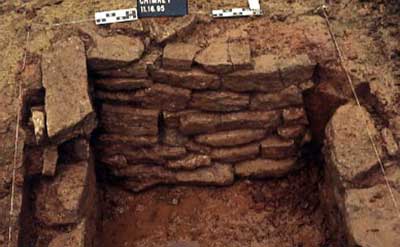In 1775, Nicholas Cresswell described Drennon Springs as "...the largest lick I ever saw. I suppose here is 50 acres of land trodden by buffaloes, but there is not a blade of grass upon it... Here is a number of salt and Brackish springs in a small compass, some of them so strong of the brine that the sun forms the salt round the edge of the Springs."
Salt making at Drennon Springs began in the winter of 1785. Producing salt from spring water required long periods of boiling and cooling to remove impurities and promote salt crystallization. A single large salt work could employ over 100 people to build furnaces, cut timber for fuel, haul kettles, and maintain fires. Many of the people who often worked these jobs were enslaved by the spring’s owner or were enslaved people rented to the owner from neighboring farms.
The furnaces documented at the Omar Adams site consisted of trenchs that ranged in length from 13 to 67 feet. They were lined with stone. Each furnace had a firing chamber with an average width of five feet and a stone-lined chimney on its eastern edge. The furnace sides were fired red from the heat, and concentrations of ash and charcoal were present along the sides and bottom of many of the furnaces. The ash and charcoal represented a furnace's final use.

On the northern edge of the longest furnace, researchers found a broken kettle incorporated into the wall of its stone lining. A second broken kettle was recovered from the firing chamber of this furnace. These are the most complete salt making kettles recovered to date from a Kentucky archaeological site.